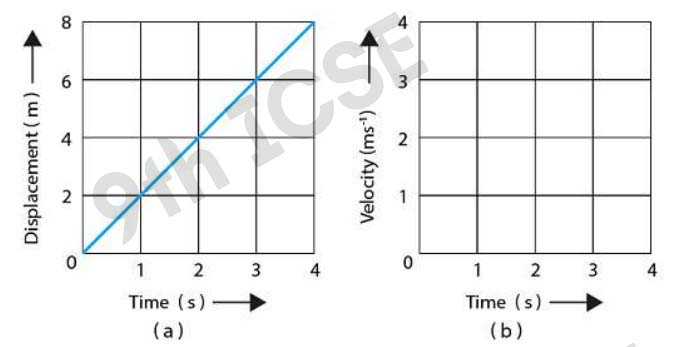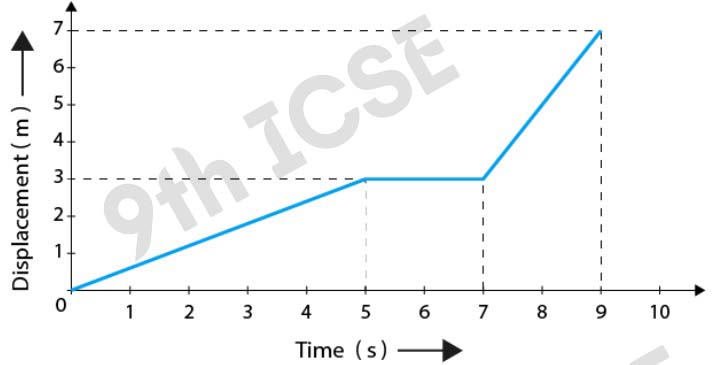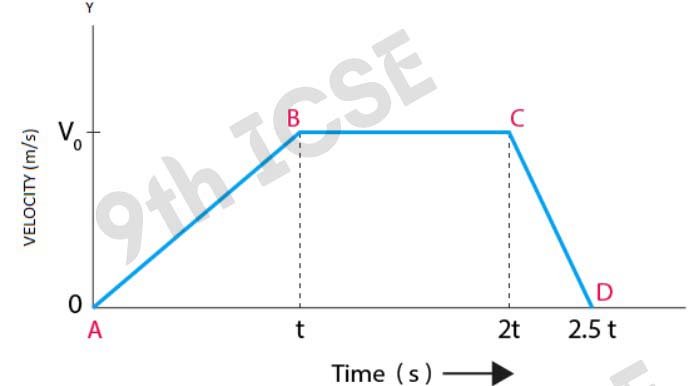Physics Motion in One Dimension Numerical2b
Please Select
Numericals
Q1 Figure shows the displacement-time graph for the motion of a body. Use it to calculate the velocity of body at t=1s, 2s and 3s, then draw the velocity-time graph for it in figure (b).

Q2 Following table gives the displacement of a car at different instants of time.
time(s) : 0 1 2 3 4
displacement(m) : 0 5 10 15 20
(a) Draw the displacement-time sketch and find the average velocity of car.
(b) What will be the displacement of car at (i) 2.5s and (ii) 4.5s?
Q3
A body is moving in a straight line and its displacement at various instants of time is given
in the following table:
time(s) : 0 1 2 3 4 5 6 7
displacement(m) : 2 6 12 12 12 18 22 24
Plot displacement-time graph and calculate:
(i) Total distance travelled in interval 1s to 5s,
(ii) Average velocity in time interval 1s to 5s.
Q4 Figure shows the displacement of a body at different times.

(a) Calculate the velocity of the body as it moves for time interval (i) 0 to 5s, (ii) 5s to 7s and (iii) 7s to 9s.
(b) Calculate the average velocity during the time interval 5s to 9s.
Q5 From the displacement-time graph of a cyclist, given in figure, find:
(i) The average velocity in the first 4s,
(ii) The displacement from the initial position at the end of 10s
(iii) The time after which he reaches the starting point.

Q6 Figure ahead represents the displacement-time sketch of motion of two cars A and B. Find:
(i) The distance by which the car B was initially ahead of car A.
(ii) The velocities of car A and car B
(iii) The time in which car A catches car B
(iv) The distance from start when the car A will catch the car B

Q7 A body at rest is made to fall from the top of a tower. Its displacement at different instants is given in the following table:
time(s) : 0.1 0.2 0.3 0.4 0.5 0.6 displacement(m) : 0.05 0.20 0.45 0.80 1.25 1.80 Draw a displacement-time graph and state whether the motion is uniform or non-uniform?
Q8 Figure shows the velocity-time graph for the motion of a body. Use it to find the displacement of the body at t=1s, 2s, 3s and 4s, then draw the displacement-time graph for it on figure (b).
Q9 Figure below shows a velocity-time graph for a car starting from rest. The graph has three parts AB, BC and CD.

(i) State how is the distance travelled in any part determined from this graph
(ii) Compare the distance travelled in part BC with the distance travelled in part AB.
(iii) Which part of graph shows motion with uniform (a) Velocity (b) acceleration (c) retardation?
(iv) (a) Is the magnitude of acceleration higher or lower than that of retardation? Give a reason.
(b) Compare the magnitude of acceleration and retardation
Q10 The velocity-time graph of a moving body is given below in figure

Find:
(i) The acceleration in parts AB, BC and CD.
(ii) Displacement in each part AB, BC, CD, and
(iii) Total displacement.
Q11 A ball moves on a smooth floor in a straight line with a uniform velocity 10m/s for 6s. At t=6s, the ball hits a wall and comes back along the same line to the starting point with same speed. Draw the velocity-time graph and use it to find the total distance travelled by the ball and its displacement.
Q12 Figure shows the velocity-time graph of a particle moving in a straight line.

(i) State the nature of motion of particle.
(ii) Find the displacement of particle at t=6s.
(iii) Does the particle change its direction of motion?
(iv) Compare the distance travelled by the particle from 0 to 4s and from 4s to 6s.
(v) Find the acceleration from 0 to 4s and retardation from 4s to 6s.
Contact Us
